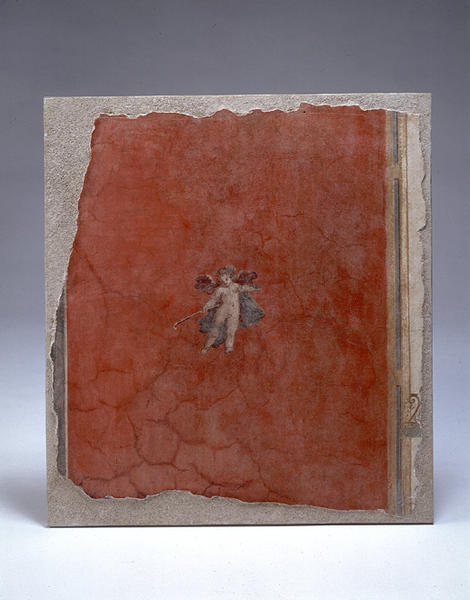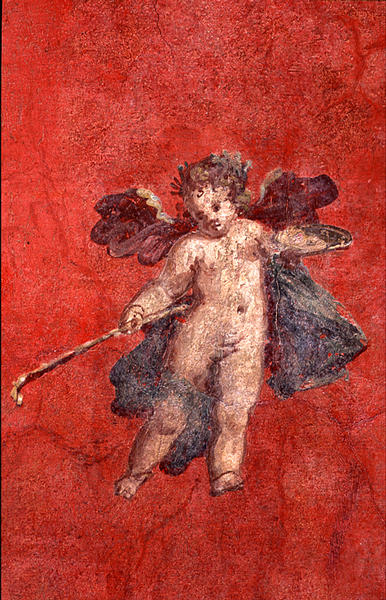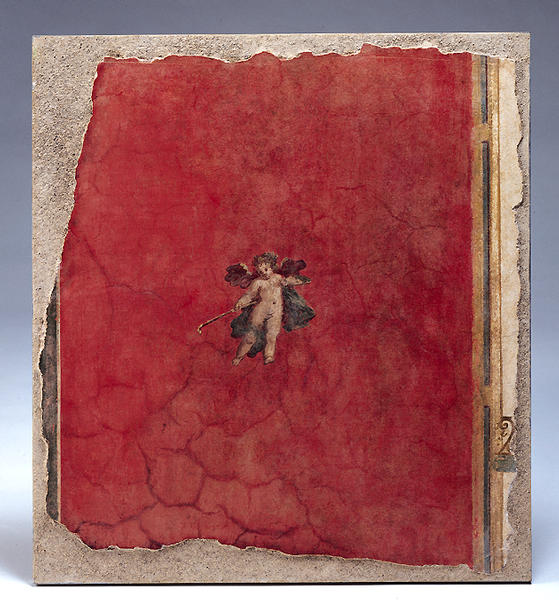キューピッド(壁画)
- ローマ
- 1世紀
- フレスコ
- H-59 W-55
赤紫の翼と風にたなびく新緑色のマントによって、まるで空中を自由に飛んでいるように表現されている。突き出した右足と左足の対比が三次元への空間を感じさせ、明暗2色で肉付けされた全身に立体感を持たせている。このキューピットは何も知らない人を待ち伏せ、手に持った羊飼いの杖の先で逢い引きの場所へ誘い込もうとしているようである。
Catalogue Entry
The subject of this now fragmentary painting is the naked, winged toddler known to the Romans as Cupid and Amor, who personified the sentiments and passion of love, a role he inherited from his Greek counterpart, Eros.1 Over time, however, the god of love had been transformed from a mature youth into a chubby, mischievous toddler. Here Cupid appears to be waiting for the arrival of some unwitting souls he can snare into a tryst with the crook of the shepherd's staff he holds in his right hand.
Floating freely, Cupid is set off from the bright red background by purple-brown wings and a fluttering gray-green mantle that crosses his right thigh. A sense of spatial depth is suggested by Cupid's advanced right leg and lagging left, and his whole body is given volume by means of modeling with dark and light colors.
A clue about original context for this painting is provided by the elements that frame it on either side. On the left is a section of a broad band of gray-green that is separated from the red field by a narrow, light-colored band. The right edge is treated differently, with a wide stripe of yellow on which are painted long, narrow rectangles of green. To the right of the yellow band is an expanse of white, and toward the bottom is a brown tendril rising from a green rectangle.
The subject matter, color scheme and framing devices of this fragment suggest that it was once part of a painting in the Third Style, which is characterized by the use of broad expanses of different colors laid adjacent to one another, separated by spindly architectural elements or decorative ornaments. When figures appear, they tend, as here, to be small and of an ornamental nature, but rendered with great precision.2 Perhaps this fragment once bordered a figural scene with a white background,3 or one that was framed in white.4
KM
1. LIMC 3 (1986), pp. 952-1049, s.v. Eros/Amor, Cupido (by Nicole Blanc and Francois Gury).
2. Ling 1991, pp. 52-62.
3. Ibid., p. 59, fig. 58.
4. Ibid., pl. VA.
解説(古代バクトリア遺宝展)
1世紀
フレスコ
縦59.0 cm 横55.0 cm
この壁画は赤色の地に黄色と淡青色の建築意匠で右側が区切られ、左側には灰緑色の枠取りが見える。中央には鳥の翼をつけたキューピッドが右手に牧羊の杖を持ち、右前方に差し出し浮遊している。ローマの壁画では様々な仕草をしたキューピッドが描かれているが、イタリアのヘルクラネウムからはヘラクレスの棍棒や弓などを弄ぶ姿が描かれた壁画が見つかっている。イタリアのボスコトレカーセからはキューピッドの配偶者であるプシュケーがディオニュソスの杖テュルソスを持って空中に浮遊している姿が描かれた壁画が見つかっているが、それにはこのキューピッドの壁画と酷似した赤色地と枠取りがなされている。プシュケーの壁画は他の断片と考え合わせて建築意匠で空間を区切る第Ⅳ様式に分類されており、キューピッドの壁画も同様の様式に分類される。このキューピッドはあるいは牧羊神を装っているのかもしれない。


